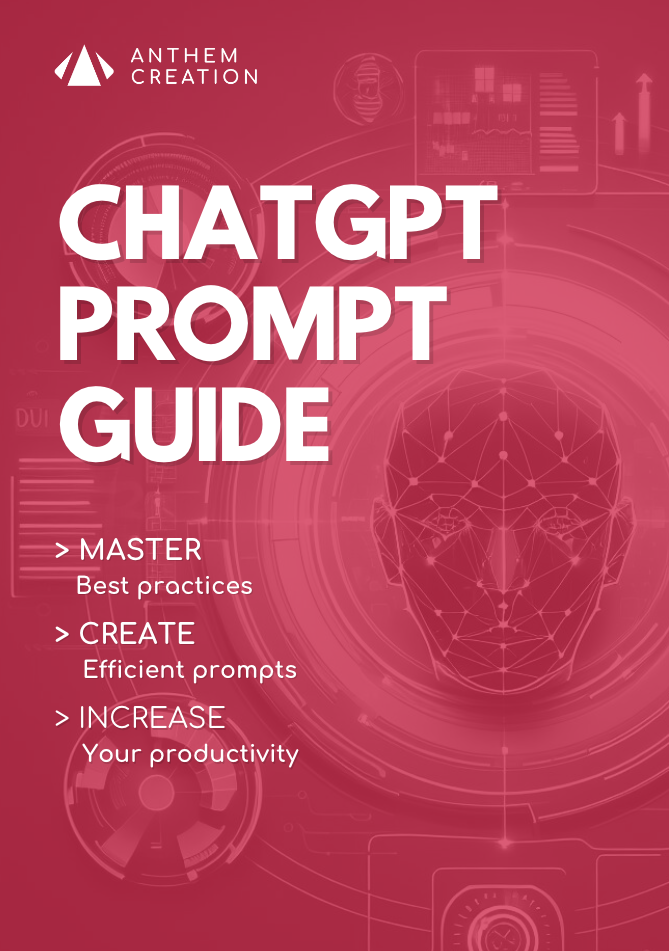Deep Research from OpenAI presents itself as a major breakthrough in the field of AI agents. It’s not just another tool, but a true AI agent capable of conducting in-depth research, analyzing data and synthesizing information autonomously.
This technology promises to radically transform the way we work and interact with information.
Listen to the AI podcast :
This article will explore the capabilities of Deep Research, its advantages, disadvantages and potential impact on the future of work.

What is Deep Research?
Deep Research is an AI agent developed by OpenAI, designed to perform complex, in-depth web searches.
This is a new capability built into ChatGPT, allowing you to conduct multi-step searches, synthesize online information and create detailed reports, all in a matter of minutes.
Deep Research is based on an optimized version of the OpenAI o3 model, specially trained for web browsing and data analysis.
How Deep Research works
- Autonomy: Deep Research works autonomously. It receives a query and finds, analyzes and synthesizes hundreds of online sources to produce a comprehensive report.
- Intelligent web browsing: The tool navigates the web, interprets text, images and PDF files, adjusting its strategy according to the information it encounters.
- Advanced Reasoning: Deep Research uses reasoning skills to search, interpret and analyze large amounts of data. It has been trained on real-world tasks requiring the use of the browser and Python tools, using the same reinforcement learning methods that enabled the development of the OpenAI o1 model.
- Production of detailed reports: The agent produces comprehensive reports, with clear citations, summaries of his or her thought process and exhaustive documentation of the sources used.
- Multimodal capability: The tool is capable of processing text, images and PDFs.
Benefits of Deep Research
The benefits of Deep Research are manifold and impact various fields, both for professionals and the general public.
Time savings and efficiency
- Search acceleration: Deep Research performs tasks in minutes that would take a human hours.
- Fast processing of large amounts of data: It can rapidly analyze and synthesize huge volumes of information, which is essential for research in complex fields.
- Workflow optimization: By automating search tasks, it enables professionals to focus on higher-value tasks.
- Identifying specific information: Deep Research is particularly effective for finding niche and non-intuitive information that requires navigating numerous websites.
Improving the Quality of Research
- Exhaustive reports: Reports generated by Deep Research are comprehensive, with clear citations and thought-process summaries.
- Objective synthesis: The tool combines information from a variety of sources, enabling a more balanced and objective analysis.
- Easy verification: Full documentation of sources makes it easy to verify information.
- Deep analysis capability: Deep Research performs complex analyses and identifies patterns in data, going beyond the capabilities of simple search.
Diversity of Applications
- Scientific and technical research: Deep Research can help with literature reviews, data analysis and report writing in fields such as science, healthcare, finance or engineering.
- Competitive analysis: Can perform competitive analyses for companies, examining competitors’ growth strategies, market positioning and products.
- Decision support: It can provide evidence-based recommendations for various sectors, such as finance, politics, and engineering.
- Personalized shopping: The tool can help consumers find personalized recommendations for major purchases such as cars, appliances or furniture.
- Legal assistance: Can extract relevant information from legal documents, such as pertinent cases and important facts.
- New product development: Helps plan and execute product launch campaigns.
Drawbacks and Limitations of Deep Research
Despite its many advantages, Deep Research has limitations and drawbacks that are essential to consider.
Cost and Accessibility
- High cost: Access to Deep Research is currently limited to subscribers of ChatGPT’s “Pro” plan, which costs $200 per month.
- Limited geographic availability : Access is still limited to certain regions such as the UK, Switzerland and the European Economic Area.
- Usage limits: “Pro” plan users are limited to 100 requests per month.
- Specific language templates : The tool is optimized for English, but this may cause problems for searches in other languages.
Technical Challenges and Reliability
- Hallucinations: Like other linguistic models, Deep Research can sometimes “hallucinate” information, i.e. produce results that are not based on real sources.
- Difficulty distinguishing reliable sources from rumors: The tool may have difficulty distinguishing information from credible sources from information from unreliable sources.
- Processing time: Searches can take between 5 and 30 minutes, which can be a disadvantage for users who need immediate results.
- Intensive computing: Deep Research requires a great deal of computing power, which explains the current limitations in availability.
Cognitive Limits
- Lack of creativity: Although Deep Research can synthesize and analyze information, it lacks human creativity and critical thinking.
- Dependence on source quality: The quality of results depends on the quality of information sources on the web.
- Difficulty understanding context: Deep Research may have difficulty understanding complex nuances in context and tone.
Examples of Limitations
- Difficulty with spatial reasoning and common sense: In some tests, Deep Research showed deficiencies in spatial reasoning and common sense.
- Errors in answers: Deep Research can provide erroneous answers, although overall performance is impressive.
- Misinterpretation of data: Models sometimes have difficulty extracting the right information from text or giving the right answer despite access to data.
Deep Research has the potential to transform many industries by automating research and analysis tasks.
What is the impact of this type of tool?
Automation of intellectual work
- Partial replacement of certain jobs: Deep Research could automate some of the tasks performed by analysts, consultants, researchers, and legal professionals. This could lead to a reduction in jobs in certain sectors.
- Role transformation: Employees could be driven to focus on higher-value tasks, such as strategic planning, creativity, and complex problem-solving, rather than basic research and analysis.
- Cost reduction for companies: By automating some of the intellectual work, Deep Research could help companies cut costs.
- Increased productivity: By performing research quickly and efficiently, Deep Research could increase employee and business productivity.
Creating new opportunities
- Emergence of new roles: The use of Deep Research could lead to the creation of new roles in companies, for example specialists in AI and data management.
- Access to information for all: By making information retrieval faster and more accessible, Deep Research could democratize access to knowledge.
- Innovation and discovery: By helping to synthesize and analyze knowledge, it could stimulate scientific innovation and discovery.
- Development of new AI agents: Deep Research could potentially create specific AI agents for particular tasks, planning and executing them.
Impact on various sectors
- Research and development (R&D): Deep Research could accelerate the process of scientific discovery and technological innovation by making it easier to find information and analyze data.
- Health: It could help in the search for new treatments, diagnosis and the personalization of medical care.
- Finance and commerce: The tool could enable companies to carry out market analyses more quickly, better target their customers, and develop new strategies.
- Law and administration: Deep Research could automate documentary research tasks and facilitate case preparation.
- Education: The tool could help students and teachers access information more easily and conduct more in-depth research.
Deep Research Facing the Competition
Deep Research’s release has shaken up the AI industry, eliciting both admiring and critical reactions.
Perplexity Sonar
Perplexity recently introduced Sonar Pro API, a competitive AI-powered real-time search solution designed to meet the needs of enterprises and developers. Here are the key features and benefits of this API:
Main features
- Real-time search: Unlike traditional AI models based on pre-trained data, Sonar Pro API accesses up-to-date information directly from the Internet, guaranteeing relevant and up-to-date results
- Improved accuracy: The API achieves an F-score of 0.858 on the SimpleQA benchmark, outperforming standard models such as GPT-4 or Claude in terms of factual fidelity
- Extended Context Window: With a processing capacity of 200,000 tokens, it can handle complex, multi-step queries, offering detailed, in-depth answers
- Extended citations: Provides twice as many citations as the standard version, enhancing the reliability and traceability of results
Reactions from Google
- Feeling of plagiarism: Some Google employees have expressed frustration at seeing OpenAI use a name similar to their own research project (Deep Research), as well as a similar approach.
- Challenges and competition: Deep Research’s release intensifies competition in the AI field, forcing Google and other companies to innovate even faster.
The Evolution of Search
- Transition from search to advanced search: The launch of Deep Research marked the end of the era of “simple search” and the beginning of the era of “deep search”. It’s no longer just about finding information, but analyzing and synthesizing it.
- Intelligence and tools: Combining reasoning models with web search tools is essential for effective and powerful AI.
- Agent autonomy: The future of AI lies in the development of autonomous agents capable of performing complex tasks autonomously.
Deep Research benchmarks
Deep Research has been tested on several benchmarks, where it has demonstrated exceptional performance.
Humanity’s last exam
- Expert Knowledge Test: This benchmark tests the AI on a wide range of topics, with expert-level questions.
- Exceptional performance: Deep Research scored 26.6% accuracy, double that of the o3 mini high.
- Human approach: The model demonstrated a “human” approach by efficiently searching for specialized information when needed.
GAIA
- Real-world questions benchmark: This benchmark evaluates AI on real-world questions, requiring reasoning skills, multimodal fluency, web navigation and tool use.
- New state of the art: Deep Research has achieved a new state of the art (SOTA) in this benchmark, outperforming all previous models.
- Improved scores: Its scores stand at 74.29% in pass@1, 67.36% in average and 78.66% in cons@64.
Expert-level tasks
- Internal evaluation: In an internal evaluation of expert-level tasks, Deep Research automated several hours of complex manual investigation.
- Correlation with economic value: AI performance is more correlated with the economic value of the task than with the time it would take a human to complete it.
- Complexity and reasoning: The tasks that models have difficulty performing are different from those that take humans time.
Advanced Deep Research usage examples
Here are a few examples of how Deep Research is used, highlighting its versatility and potential impact:
- Analysis of mobile operating system adoption: Deep Research can provide detailed data on iOS and Android adoption in different countries, as well as interest in language learning, to help companies identify target markets for their translation apps.
- Study improving the efficiency of cellular reprogramming: The tool is able to summarize scientific articles and studies on protein mutations to improve cellular reprogramming. It identifies the most modified areas and the reasons for their effectiveness.
- Button usability analysis: Deep Research can synthesize studies on the usability of buttons with icons and labels, to provide recommendations on best practice in user interface design.
- Custom snowboard search: Deep Research can help a user choose the perfect snowboard based on their preferences, taking into account specific snow conditions, terrain type, budget and personal taste.
- Dialogue translation: Deep Research can translate dialogues into English using a Creole language with specific features from different languages, while explaining the translation process.
- Search for gene therapies: The tool can provide a comprehensive overview of gene therapies approved for the treatment of hemophilia, including the name of the developing company, the year of approval, and the viral vector technologies used.
- Analysis of DeepSeek’s R&D history: Deep Research is able to conduct in-depth analyses of DeepSeek’s R&D history and draw relevant conclusions.
A promising future, but with caution
Deep Research represents a leap forward in the field of artificial intelligence. Its ability to carry out in-depth research, analyze data and synthesize information autonomously opens up new prospects for a wide range of industries.
Key points to remember
- Autonomy and efficiency: Deep Research automates complex and time-consuming search tasks, saving significant time and efficiency.
- Detailed, accurate reports: The tool produces exhaustive reports, with clear citations and summaries of the thought process.
- Transformative potential: Deep Research could transform many sectors by automating certain tasks and freeing up human potential.
Deep Research is not just a tool, but an important step towards a future where artificial intelligence will play an increasingly important role in our lives. By understanding its capabilities and limitations, we can better prepare for this future and make the most of these technologies.
FAQ: Essential questions about Deep Research
To deepen your understanding of Deep Research, here’s a FAQ gathering the most frequently asked and relevant questions :
1. What distinguishes Deep Research from other AI-based search tools?
Deep Research stands out for its autonomy and ability to conduct complex multi-stage searches, synthesizing information from hundreds of online sources. Unlike other tools that can provide quick answers, Deep Research is designed to perform in-depth analysis and generate detailed reports, similar to those of an experienced research analyst.
2. What are the main differences between Deep Research and GPT-4o?
GPT-4o is ideal for real-time multimodal conversations, while Deep Research is designed for complex and specific queries where depth and detail are essential. Deep Research performs in-depth research and cites every source, offering a well-researched and verifiable answer, unlike GPT-4o’s quick summary.
3. Can Deep Research be used in all sectors?
Yes, Deep Research is versatile and can be applied in many sectors, including finance, science, politics, engineering, law, administration, and even for personal purchasing decisions. Its aim is to assist in all tasks requiring in-depth information research.
4. Is Deep Research capable of understanding and processing images and PDF files?
Yes, Deep Research has the ability to process text, images and PDF files during its searches. This multimodal capability enables it to extract relevant information from different types of content available online.
5. How long does it typically take for Deep Research to perform a search?
Deep Research can take between 5 and 30 minutes to complete a full search, as it navigates deep into the web. This time is necessary to enable it to carry out a detailed analysis and collect information exhaustively.
6. What are the main drawbacks of Deep Research?
The main drawbacks of Deep Research include its high cost, limited availability, the risks of hallucination and difficulty in distinguishing reliable sources from rumors, as well as processing time. However, OpenAI continues to work to improve these aspects.
7. Can Deep Research automate all search-related jobs?
No, Deep Research can automate some research-related tasks, but it can’t completely replace human labor. Human intelligence, creativity and critical thinking remain essential for complex, non-standardized tasks. Deep Research can serve to increase human potential.
8. How is Deep Research trained?
Deep Research is trained using reinforcement learning on complex web browsing and reasoning tasks. It uses methods similar to those used for OpenAI o1. This enables it to plan ahead, execute multi-stage searches and adapt to the information it encounters in real time.
9. What is the significance of the “Humanity’s Last Exam” benchmark for Deep Research?
“Humanity’s Last Exam” is a benchmark that tests AI on a wide range of topics with expert-level questions. Deep Research achieved a high score of 26.6% on this benchmark, indicating outstanding performance. This demonstrates its ability to search for and use specialized information effectively.
10. Can Deep Research be used to create new knowledge?
Yes, Deep Research is designed to synthesize existing knowledge and discover new information. The tool is an important step towards OpenAI’s goal of developing general artificial intelligence (AGI) capable of conducting innovative scientific research.
AI NEWSLETTER
Stay on top of AI with our Newsletter
Every month, AI news and our latest articles, delivered straight to your inbox.

CHATGPT prompt guide (EDITION 2024)
Download our free PDF guide to crafting effective prompts with ChatGPT.
Designed for beginners, it provides you with the knowledge needed to structure your prompts and boost your productivity
With this ebook, you will:
✔ Master Best Practices
Understand how to structure your queries to get clear and precise answers.
✔ Create Effective Prompts
The rules for formulating your questions to receive the best possible responses.
✔ Boost Your Productivity
Simplify your daily tasks by leveraging ChatGPT’s features.
Similar posts
How OpenAI’s o3-mini model pushes the limits of development and reasoning
Recently, OpenAI unveiled the o3-mini model , a more compact, fast and economical version of its reasoning tools. Designed to meet the demands of STEM (science, technology, engineering and mathematics) …
OpenAI O3 and O3 mini : Towards artificial general intelligence
OpenAI has revealed two revolutionary new artificial intelligence models, O3 and O3 mini, which mark a major turning point in the quest for general artificial intelligence (AGI). These models, with …
How to choose the best version of ChatGPT for your projects?
GPT-4o, GPT-o1, GPT Canvas… Not easy to find your way around all these versions of ChatGPT. Each model has its strengths, its particularities, and it’s not always easy to know …


